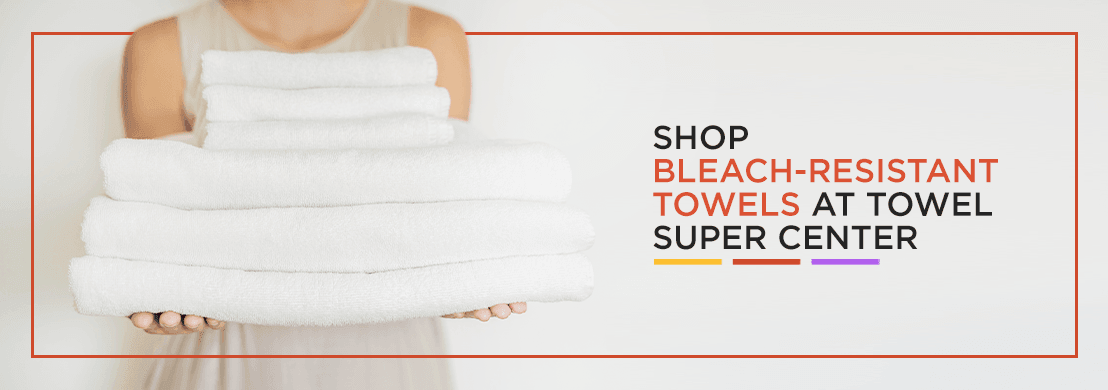What Causes Towels to Change Color?
- Created: Thursday, 21 January 2021 17:21
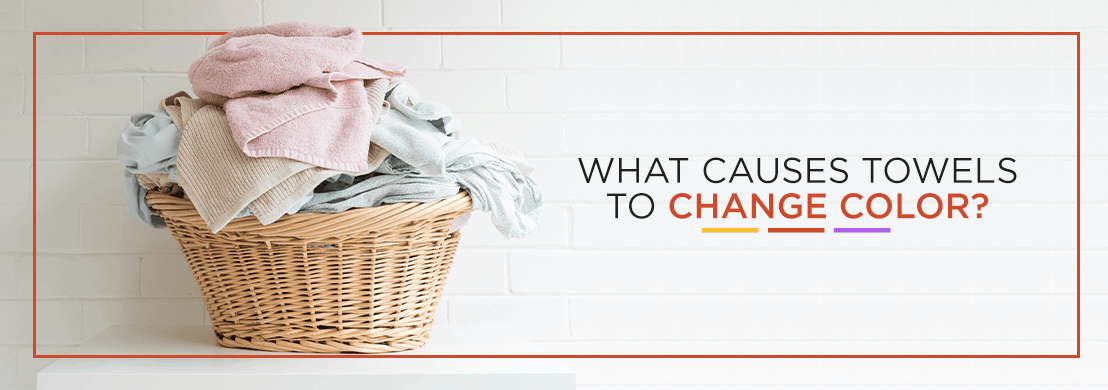
Are you seeing spots — on your towels, that is? It's an annoying yet all too common problem. Your gorgeous towels, no matter what color, suddenly have discolored spots on them that just won't come out in the wash. There are many causes for bleached spots and discolored spots on towels, and getting to the bottom of this problem can help you fix it and prevent future spots on your towels. Let's take a closer look at just what can cause discolored towels and what to do about it.
What Are the Bleach Stains on My Towels?
If your business uses colored towels, you may notice what looks like bleach stains on them occasionally. But what if you're not even using bleach on your towels? These splotches can be a mystery, but there are several likely culprits, and some of them may surprise you. These discolored spots appear as white spots or areas that are a much lighter color than the rest of the towel. This is because bleach and other chemicals that act like bleach actually remove color from the fabric, leaving behind what looks like a white or yellowed stain. The unsightly stains are not very likely to come out in the wash and can be very frustrating to deal with. Many of these discolored towels are essentially ruined and will need to be replaced, although some can be fixed, and future stains can be prevented with a few tips.
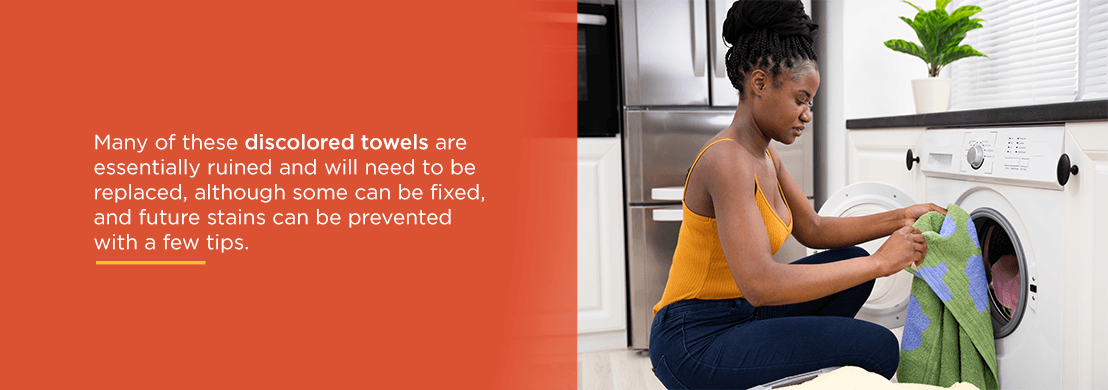
What Causes Discolored Spots on My Towels?
Many different things can cause bleached spots or discolored spots on towels, and it can sometimes be hard to pinpoint the exact cause, especially for a business dealing with a much higher volume of towels and spots that may not be noticeable until after they've been laundered. Some of these causes are more obvious, like spilled bleach, and others are a bit more sneaky. But it's a good idea to understand the possible causes so that you can determine the source of your discolored towels issue. Here are some of the most common causes of towel discoloration:
- Bleach: Let's start with the obvious cause — bleach. We all know that this can cause white spots on just about any fabric, and while it is a powerful cleaning agent, it shouldn't be used on colored towels or other materials. However, accidents can happen! Find out if your staff is using bleach to launder your colored towels or if your regular detergent contains bleach. Another possible issue could be if the towels are being used to wipe up messes or spills of cleaning products containing bleach or as cleaning rags with bleach cleaners.
- Other cleaning products: It's not just straight bleach that may be the problem. Many other cleaning sprays and solutions contain some bleach or other chemicals that can also discolor fabrics. If you use cleaning sprays containing bleach or other harsh chemicals, any towels nearby can absorb the airborne particles of cleaning solution, and over time, these particles can sink in and discolor the towels.
- Washing rags with other towels: If your towels are mixed in with cleaning rags in the laundry, this could be the source of the problem. Cleaning rags used with bleach or bleach-containing cleaning products can leach these products into the laundry, and your other towels can absorb the chemicals and come out with white or discolored spots.
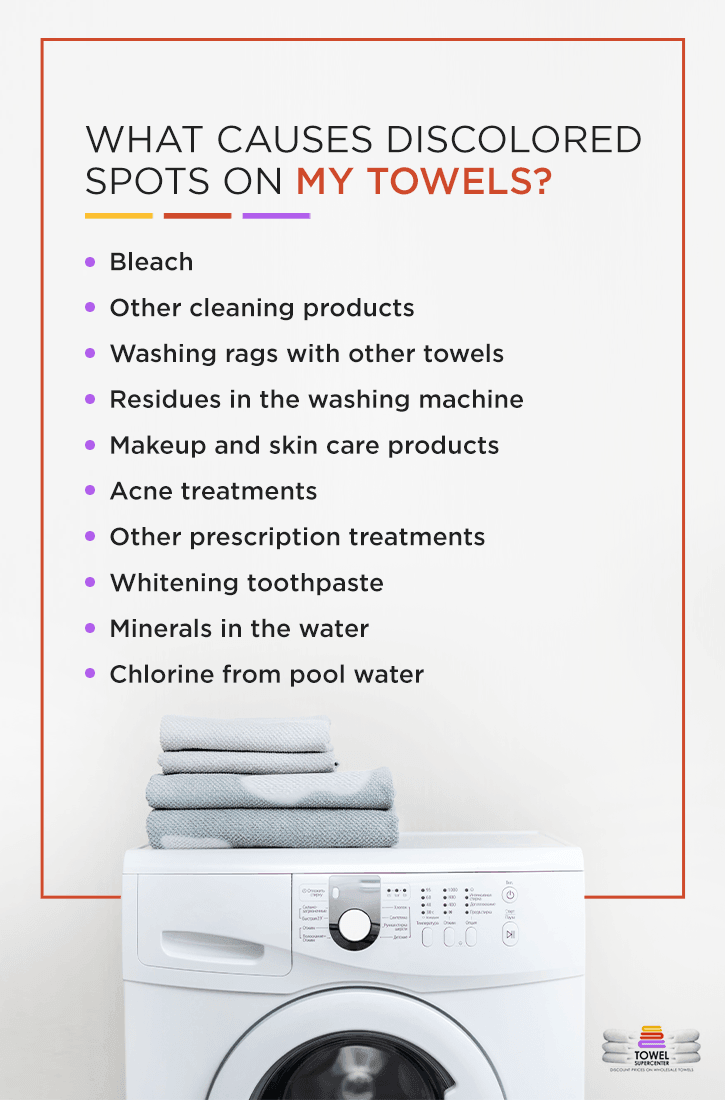
- Residues in the washing machine: Sometimes, even when you are not using bleach in your load of towels or washing them with other rags used for cleaning with bleach, residues remaining from previous washing loads could be the sneaky culprit. If your washing machine has an automatic bleach dispenser, it's very common for a little bit of bleach to remain in the dispenser and leak out in a future load, even when you don't want it to.
- Makeup and skin care products: Many different skin care or body care products have ingredients that can leave discolored spots on towels. And many makeup products leave behind bleached spots or residues that are difficult to wash out.
- Acne treatments: Another incredibly common source of discolored towels is certain types of acne medications and treatments. Many of these products contain benzoyl peroxide, which is a great ingredient for treating and preventing acne but is not so great for colored towels. This ingredient can be found in facial washes, moisturizers, medications, spot treatment creams and more. If clients are using any of these products on their faces and then wiping their faces with the towels, the products can collect on the towels and leave discolored areas behind.
- Other prescription treatments: Prescription-strength topicals are available for various skin issues, including acne, eczema, vitiligo and many other conditions. But these treatments can contain some strong ingredients that can be tough on your towels and leave discolored spots.
- Whitening toothpaste: Some of the ingredients that help keep our teeth shiny and white can also be harsh on our towels. Bleaching agents in toothpaste, mouthwash, whitening treatments and other dental products can leave discolored spots on towels. Clients may be using some of these products and wiping their faces on the towels, leaving behind residues that can lead to bleached spots on the towels.
- Minerals in the water: The source of the discoloration on your towels might even come directly from your water supply. Hard water contains extra minerals that towels absorb. These mineral deposits are difficult to wash out and can build up even more over time. The mineral buildups can lead to discolored spots on your towels. The minerals could also be building up inside the washing machine, and the towels may be picking up the extra minerals in the wash cycle. This may result in rusty-colored spots on lighter towels.
- Chlorine from pool water: Chlorine bleach is added to many pools to make the water safe for swimmers and keep bacteria at bay. And while it is so diluted that it's not an issue if some pool water splashes onto towels or clothing, repeated exposure can build up over time, making fabrics look faded. This is a common issue for hotels, resorts, spas, and other businesses with pools, as the towel supply has constant and repeated exposure to the pool water.
What Causes Discolored Spots on My Towels?
Many different things can cause bleached spots or discolored spots on towels, and it can sometimes be hard to pinpoint the exact cause, especially for a business dealing with a much higher volume of towels and spots that may not be noticeable until after they've been laundered. Some of these causes are more obvious, like spilled bleach, and others are a bit more sneaky. But it's a good idea to understand the possible causes so that you can determine the source of your discolored towels issue. Here are some of the most common causes of towel discoloration:
- Bleach: Let's start with the obvious cause — bleach. We all know that this can cause white spots on just about any fabric, and while it is a powerful cleaning agent, it shouldn't be used on colored towels or other materials. However, accidents can happen! Find out if your staff is using bleach to launder your colored towels or if your regular detergent contains bleach. Another possible issue could be if the towels are being used to wipe up messes or spills of cleaning products containing bleach or as cleaning rags with bleach cleaners.
- Other cleaning products: It's not just straight bleach that may be the problem. Many other cleaning sprays and solutions contain some bleach or other chemicals that can also discolor fabrics. If you use cleaning sprays containing bleach or other harsh chemicals, any towels nearby can absorb the airborne particles of cleaning solution, and over time, these particles can sink in and discolor the towels.
- Washing rags with other towels: If your towels are mixed in with cleaning rags in the laundry, this could be the source of the problem. Cleaning rags used with bleach or bleach-containing cleaning products can leach these products into the laundry, and your other towels can absorb the chemicals and come out with white or discolored spots.
- Residues in the washing machine: Sometimes, even when you are not using bleach in your load of towels or washing them with other rags used for cleaning with bleach, residues remaining from previous washing loads could be the sneaky culprit. If your washing machine has an automatic bleach dispenser, it's very common for a little bit of bleach to remain in the dispenser and leak out in a future load, even when you don't want it to.
- Makeup and skin care products: Many different skin care or body care products have ingredients that can leave discolored spots on towels. And many makeup products leave behind bleached spots or residues that are difficult to wash out.
- Acne treatments: Another incredibly common source of discolored towels is certain types of acne medications and treatments. Many of these products contain benzoyl peroxide, which is a great ingredient for treating and preventing acne but is not so great for colored towels. This ingredient can be found in facial washes, moisturizers, medications, spot treatment creams and more. If clients are using any of these products on their faces and then wiping their faces with the towels, the products can collect on the towels and leave discolored areas behind.
- Other prescription treatments: Prescription-strength topicals are available for various skin issues, including acne, eczema, vitiligo and many other conditions. But these treatments can contain some strong ingredients that can be tough on your towels and leave discolored spots.
- Whitening toothpaste: Some of the ingredients that help keep our teeth shiny and white can also be harsh on our towels. Bleaching agents in toothpaste, mouthwash, whitening treatments and other dental products can leave discolored spots on towels. Clients may be using some of these products and wiping their faces on the towels, leaving behind residues that can lead to bleached spots on the towels.
- Minerals in the water: The source of the discoloration on your towels might even come directly from your water supply. Hard water contains extra minerals that towels absorb. These mineral deposits are difficult to wash out and can build up even more over time. The mineral buildups can lead to discolored spots on your towels. The minerals could also be building up inside the washing machine, and the towels may be picking up the extra minerals in the wash cycle. This may result in rusty-colored spots on lighter towels.
- Chlorine from pool water: Chlorine bleach is added to many pools to make the water safe for swimmers and keep bacteria at bay. And while it is so diluted that it's not an issue if some pool water splashes onto towels or clothing, repeated exposure can build up over time, making fabrics look faded. This is a common issue for hotels, resorts, spas, and other businesses with pools, as the towel supply has constant and repeated exposure to the pool water.
How Can I Fix Discolored Spots on Towels?
Finding discolored spots on towels is incredibly frustrating. If the spots don't come out after normal laundering, it may seem that there's not much you can do to remove them. And unfortunately, sometimes, there aren't many easy fixes for discolored towels caused by bleach spots. However, depending on the cause of the discoloration and the color of your towels, there are a few tricks you can try that may restore the color of your towels. Many stains are caused by a substance depositing extra colors onto the fabric, but bleach stains actually remove pigment from the fabric, meaning these stains are more permanent, and fixing them is often less about removing the stain and more about restoring the color to the spot. If you've got towels with discolored spots from bleach products, try these ideas:
- Neutralize the bleach: If the problem with your towels is from a more direct bleach spill instead of smaller repeated exposures to bleach products over time, the first step is to neutralize the bleach spot as soon as possible. Leaving bleach on fabric for too long will discolor the fabric, of course, but it can also start to eat away at it and leave behind a hole. In cases of a bleach spill or larger bleach contamination on your towels, first, rinse with cool water as quickly as possible. This helps rinse away much of the bleach instead of letting it sink into the fabric. After rinsing, make a paste of baking soda and water and apply this to the affected areas. This will help neutralize the remaining bleach on the towels. Leave your baking soda paste on until it feels dry, then brush off and launder your towels as usual.
- Use rubbing alcohol: If the bleach stain is small, you can dry dabbing the area with rubbing alcohol. This can sometimes lift some of the surrounding color and redistribute it to the bleached area. This method might not work on towels because towels often don't have excess dye in them, but it is worth trying if you want to even out the color on a smaller stain.
- Even out color with diluted bleach: Another option is to dilute some bleach and wash the whole towel in the diluted solution. This doesn't restore the original color of the towel, but it can even out the overall color and make the whole towel a lighter color to match the discolored spot more closely.
- Restore color with markers or dye: If the bleach stains aren't too large, you can try to fill in the spots with markers. Try to match the colors exactly and use permanent ink, not washable markers, or the color will come out again the next time you wash. The permanent marker method works especially well on black fabric, although any towel can be a little tricky because of the looped texture of the fabric. An even better fix is to use fabric dye. You can use this to re-color the stained spots or just dye the entire towel with the fabric dye, following the directions on the package. Use a dye fixative product to set the color more permanently. The resulting colors may be a bit uneven but will be better than the original bleached stains.
- Remove yellow bleach stains from white towels: Bleach stains on white fabrics are some of the easiest bleach stains to work with. Because the towels are already white, no color is removed, but sometimes a yellowed stain is left behind. In this case, you can try blotting with rubbing alcohol around the stain or try a dye remover product, following the instructions on the package. Avoid drying the towels until you are satisfied with the level of stain removal, as the dryer can set the stains permanently.
- Replace your towels with new ones: Sometimes the easiest solution is simply to replace the damaged towels. This ensures your business always has the best, top-quality towels available for clients to use. Try to get to the bottom of the cause of the discoloration so it doesn't happen again with your new towels, and repurpose the old, discolored towels for a different use, such as cleaning rags.
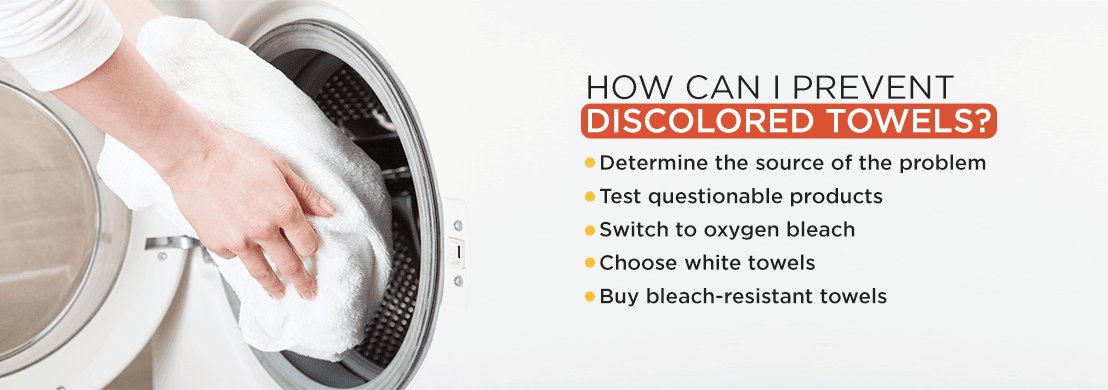
How Can I Prevent Discolored Towels?
Discolored towels can be difficult to fix, and prevention is the key to preserving your towels and keeping them looking their best for your clients. Here are our best tips for preventing bleach stains on towels:
- Determine the source of the problem: If bleach stains and discolored towels are ongoing problems for your facility, try to figure out the cause and see what changes you can make to prevent it in the future. It could be as simple as getting new cleaning products or changing the way you do the laundry.
- Test questionable products: If you have a new cleaning product or skin care product in your business, do a test run on a small area of one of your towels before introducing it to more widespread use. If it stains the test spot, you may want to consider a different product or different towels.
- Switch to oxygen bleach: If you like using bleach-based products for laundry or other cleaning duties, consider switching to an oxygen-based bleach. This bleach formula is safer for fabrics and less corrosive, yet still effective for cleaning. The bonus to using an oxygen bleach is that it is also more eco-friendly.
- Choose white towels: For any purposes where the towels may come in contact with bleach products, such as poolside towels, or face towels that might be used with acne treatments or teeth whitening treatments, have an ample supply of white towels available. This way, any bleach or related products won't discolor the towels as easily.
- Buy bleach-resistant towels: Make sure this problem doesn't affect your next batch of towels by purchasing bleach-resistant towels. These towels are dyed using a special process that makes them more color-fast than other types of towels. So, if bleach products or other sneaky chemicals that cause discoloration are simply unavoidable in your business, this is the way to go.
Shop Bleach-Resistant Towels at Towel Super Center
If bleach spots are a common problem for your business, and you find that your towels change color with normal use, it's time to consider bleach-resistant towels from Towel Super Center. Our bleach-resistant towels are manufactured and dyed using a special process that makes them more colorfast and resistant to the effects of bleach and other chemicals. They are available in a wide variety of sizes and colors to meet the needs of any business. Our budget-friendly choices mean you can stock your supplies without compromising your profits and provide the highest quality towels for your customers. Shop online with us today, and contact our helpful staff with any questions.




